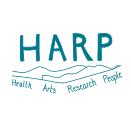Our HARP Approach outlines what we think are the four stages of an arts and health innovation process. It illustrates what a people-powered innovation process can look like for teams and projects that want to use the arts to improve people’s health and wellbeing, or to meet health and care challenges. The ultimate aim? To transform health systems.
What the HARP approach …
Is
- a model for an innovation process in arts and health, showing at least four defined stages, each with distinct features and aims
- a way of approaching innovation that centres around learning, collaboration and transforming health systems
- a tool to empower people working in this area to be analytical and reflective about their innovation projects, and to ask others for support as needed
Was
- co-created with the 13 arts and health innovation teams we worked with in HARP
- based on the HARP team’s practical observations, informed by data collected by the HARP researcher
- inspired by other models including Nesta’s innovation spiral, the People Powered Results innovation conditions wheel, and the Culture, Health and Wellbeing Alliance’s Thriving Practice Model.
Isn’t
- an all-encompassing process for a perfect arts and health project: every project is different and not all four stages or elements of the HARP approach will be right for all projects
- a quality or skills framework for artist practitioners working in health, as this sits outside HARP’s remit; for this please refer to Wales Arts, Health and Wellbeing Network’s Quality Framework and Code of Practice




